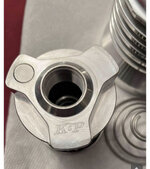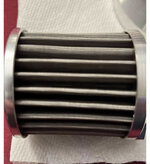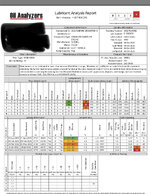Well it took a month but I finally got the particle count results back for the K&P stainless mesh reusable oil filter. As expected, it didn't do as well as the Fram Ultra, but I expected worse actually. Same oil and OCI as last time when I ran the Fram Ultra, so about as apples to apples comparison as I could get. Your thoughts? I think I'm going to stick with the Fram Ultra, Endurance or Amsoil oil filters. 


You are using an out of date browser. It may not display this or other websites correctly.
You should upgrade or use an alternative browser.
You should upgrade or use an alternative browser.
Particle Count Comparisons! Fram Ultra vs K&P Reusable Stainless Mesh oil filter
- Thread starter dezlpwr
- Start date
Looks like below 20u the stainless mesh really loses efficiency, which would be expected since the mesh is a fixed size. What does K&P say the efficiency is on that filter? It did pretty good above 20u, better than expected so it must be ultra fine screen.
dezlpwr
Thread starter
They claim it is 35 absolute. Seems to be pretty close to that don't you think? It is a very fine screen.
"Absolute" efficiency in the filter world typically means 98.7% (call it 99%) efficiency. Yes, that does seem about right - 99% @ 35u.They claim it is 35 absolute. Seems to be pretty close to that don't you think? It is a very fine screen.
dezlpwr
Thread starter
Yessir! Very strong one.Does the mesh filter have a built in magnet anywhere?
Attachments
dezlpwr
Thread starter
"Absolute" efficiency in the filter world typically means 98.7% (call it 99%) efficiency. Yes, that does seem about right - 99% @ 35u.
Attachments
"Absolute" efficiency in the filter world typically means 98.7% (call it 99%) efficiency. Yes, that does seem about right - 99% @ 35u.
Better than my honda AO2's If I recall.
The title is a little much, but Lake Speed Jr. tested a mesh filter compared to a 'regular' one. Came to much the same conclusion. I wish they'd looked at a few main or rod bearings between tests.
Edit:
They did the teardown, I just missed it.
Edit:
They did the teardown, I just missed it.
Last edited:
I think it’s very interesting that the very metal screen filter did a fairly decent job being absolute efficient near 35 microns.
And did Lake Speed fool around with a lady who looked a whole lot like a squirrel ? Because great day their son looks like a squirrel…
And did Lake Speed fool around with a lady who looked a whole lot like a squirrel ? Because great day their son looks like a squirrel…
One thing they didn't really clarify is that the oil particle count is the number of particles per milliliter (mL). So multiply that number by the number of mL in 5 qts of oil. They made it sound like it was the total number of particles in the entire 5 qt sump.
So with 20,000 particles that are 4μ and larger per mL, that would be 20,000 x 946 x 5 = 94,600,000 total particles in 5 qts.
So with 20,000 particles that are 4μ and larger per mL, that would be 20,000 x 946 x 5 = 94,600,000 total particles in 5 qts.
Last edited:
One thing they didn't really clarify is that the oil particle count is the number of particles per milliliter (mL). So multiply that number by the number of mL in 5 qts of oil. They made it sound like it was the total number of particles in the entire 5 qt sump.
So with 20,000 particles that are 4μ and larger per mL, that would be 20,000 x 946 x 5 = 94,600,000 total particles in 5 qts.
That was bugging me too, I think they just dumbed it down for the average person or just forgot to mention it. I get the impression LSJr is about like the dog in 'UP' SQUIRREL!! Very animated, very passionate, and a bit scattered.
.
Good Morning Dezlpwr,Well it took a month but I finally got the particle count results back for the K&P stainless mesh reusable oil filter. As expected, it didn't do as well as the Fram Ultra, but I expected worse actually. Same oil and OCI as last time when I ran the Fram Ultra, so about as apples to apples comparison as I could get. Your thoughts? I think I'm going to stick with the Fram Ultra, Endurance or Amsoil oil filters.View attachment 189720View attachment 189721
First I want to applaud you on your testing . . . same oil, same miles, similar weather conditions. A good test to see the impact of the only change, the filter. Really well done.
I'm impressed how well the K&P stainless mesh did on the wear metals, the results are practically identical for both filters. The only differences are in the particle counts but I'm not experienced on how that translates to engine wear over the life of an engine.
Based on your results the deciding factor would be the convenience factor of a spin on versus the reusable having a big plus for the environment.
Again, great job in your testing. To you and your family, have a wonderful Thanksgiving!
The 6 um size is really high and the ultra really collects that size substantially better. I see the copper ticked up just 1 more number. Was that additional wear? Lol. Im Not seeing any really wild wear though. Will that filter contribute to a dirty engine. Well we see the oil did a good job collecting and holding all of that extra particles even if it passed through the filter. We might claim "terrible efficiency" but here we are and there is no boogyman. 
Great job testing
Great job testing
If the particle counts are truly a reliable indicator, then the K&P reuseable did better than I would have expected.
That said, personally I agree with your intention going forward to use the filters you mentioned.
Good job trying to minimize the variables involved with the comparison.
That said, personally I agree with your intention going forward to use the filters you mentioned.
Good job trying to minimize the variables involved with the comparison.
Last edited:
dezlpwr
Thread starter
Funny you mention copper. I sent the same exact sample to OA/Horizon and they have copper going down not up....The 6 um size is really high and the ultra really collects that size substantially better. I see the copper ticked up just 1 more number. Was that additional wear? Lol. Im Not seeing any really wild wear though. Will that filter contribute to a dirty engine. Well we see the oil did a good job collecting and holding all of that extra particles even if it passed through the filter. We might claim "terrible efficiency" but here we are and there is no boogyman.
Great job testing
Attachments
I think particle count tests tend to understate the differences in efficiency between filters. Even if an engine is run without an oil filter, it will eventually grind down any particle much larger than 1 micron, and these particles end up being undetectable. This tends to happen on time periods measured in mere minutes of engine operation. Some other particles end up in deposits. So the engine kind of acts as its own oil filter, but of course the result is increased wear.If the particle counts are truly a reliable indicator, then the K&P reuseable did better than I would have expected.
It's possible that the K&P was nearly 0% efficient at 6-13 micron, yet still managed to "only" have 10 times the particle count compared to the FRAM.
Since there was no obvious increase in wear metals with the K&P filter, I think we can assume that the oil just wasn't dirty enough for abrasive wear from particles to be a significant source of wear. If the car had poor air filtration, or high wear metal generation from another cause, the oil filter efficiency would be a lot more important.
Yeah, that was my LOL part after that statement b/c it's all within except-able variance. Even the Al looks like it's two PPM lower than the Fram UltraFunny you mention copper. I sent the same exact sample to OA/Horizon and they have copper going down not up....
@dezlpwr
Since you seem to be willing to sacrifice engine protection for the sake of science, it would be interesting to see a UOA done on an OCI without the Baxter anti-drainback adapter to see if there's a meaningful increase in wear without it. You'd have to use a smaller filter with an M20 thread, and if you kept using a FRAM Ultra, it would have to be one that would bypass some oil occasionally due to the lower bypass setting. That would confound the result a bit, but a "bypass filter" test could be interesting on its own.
Since you seem to be willing to sacrifice engine protection for the sake of science, it would be interesting to see a UOA done on an OCI without the Baxter anti-drainback adapter to see if there's a meaningful increase in wear without it. You'd have to use a smaller filter with an M20 thread, and if you kept using a FRAM Ultra, it would have to be one that would bypass some oil occasionally due to the lower bypass setting. That would confound the result a bit, but a "bypass filter" test could be interesting on its own.
The down side with the wear metals measurement in a low cost UOA is that it can only detect particles no larger than around 5-7 microns. So if there is wear metal larger than that, they will not be seen in the UOA.I'm impressed how well the K&P stainless mesh did on the wear metals, the results are practically identical for both filters. The only differences are in the particle counts but I'm not experienced on how that translates to engine wear over the life of an engine.
If the particle counts are much larger like seen in the Lake Speed video, than that means the oil has way more possible wear particles in it. Many "oil cleanliness vs engine wear" papers say that lots of wear can result from particles less than 20 microns. That is why the Lake Speed video showed that the bearings got damaged (and the engine even lost power on the dyno) when the oil wasn't filtered very well in the smaller micron range with the metal mesh filter.
Similar threads
- Replies
- 49
- Views
- 8K
- Replies
- 49
- Views
- 6K
- Replies
- 52
- Views
- 3K



